The Mystery Of Cage Cups
Diatretic Glass: Masterpieces of Ancient Roman Craftsmanship
“Diatretum” or “diatretic glass” refers to a type of ancient Roman glassware known for its intricate and delicate openwork designs. These objects are often considered masterpieces of Roman craftsmanship and are highly valued in the world of ancient art and archaeology.
The Cage Glasses
A diatret glass, also known as a cage cup, is a bell-shaped double-walled vessel adorned with pierced glass. Comprising an inner beaker and an outer cage or decorative shell, the diatreta is attached to the cup’s body by short stems or shanks, creating a captivating perforated glass mesh. Referred to as net cups or cage cups, these vessels were highly valued showpieces in Roman times, with laws regulating potential damages caused by cup grinders.
The earliest diatreta, dating back to the 1st century, did not feature the characteristic network but displayed various motifs. The pinnacle of glass cutting artistry was reached in the 3rd and 4th centuries AD, with over 70 examples known today, although many have survived only as fragments.
The precise purpose of diatretic glass continues to be a topic of scholarly debate. Some theories propose that these vessels served as luxury items, possibly utilized for showcasing precious objects or serving special drinks during banquets. Alternatively, suggestions include their role as votive offerings or possessing ceremonial significance. Often resembling cups, cage glasses were primarily regarded as drinking vessels, featuring toasts such as “Bibe multis annis” (Drink [that you may live] for many years!). Martial’s poem and historical evidence point to their specialized use at symposiums and other events.
Archaeological Discoveries
Many diatretic glass pieces have been unearthed in archaeological excavations, particularly in regions that were once part of the Roman Empire. These discoveries contribute to our understanding of Roman art, technology, and the tastes of the elite during this period.
In summary, diatretic glass represents a remarkable chapter in the history of Roman craftsmanship. The skillful combination of intricate design and delicate execution makes these pieces both functional and artistic. The surviving examples stand as testaments to the technical prowess of ancient glassmakers and provide valuable insights into the aesthetic preferences of the Roman elite.
The ancient technique of crafting diatret glass remains somewhat mysterious. In a 1906 experiment, German scientists attempting to cut a cage cup filled with champagne found that the rim broke off immediately when the cutter began to drink, adding an intriguing layer to the enigma of these remarkable artifacts.
The Distilling Culture
BLOG
Embark on a global journey, and you’ll find that cultures possess tales that harken back to their ancient beginnings of distillation, brewing, and winemaking.
info@houseofapplejay.com
67 Fowler St, Bldg B, East Ellijay, GA 30540

